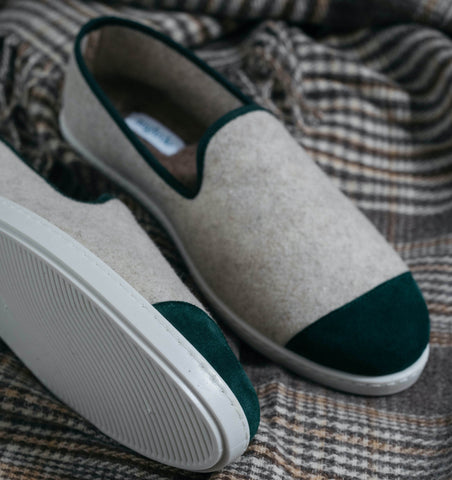Wool, but what is it?
Wool is a natural fiber of animal origin, mainly obtained from the fleece of sheep but also that of alpacas, goats and llamas.
For centuries, wool has been used to protect against cold and humidity. It is a tradition in the Pyrenees to work this material using know-how passed down from generation to generation. Nowadays, thanks to its easy export, there are different kinds of it that are easy to access, with varied prices and often said to be complementary properties.
It is widely used in the textile industry for manufacturing clothing, blankets, carpets and other products. A woolen material naturally has antibacterial properties which allow it to repel the bacteria responsible for bad odors. Wool is an eco-friendly material compared to synthetic materials such as acrylic; it is a resistant and biodegradable fiber, appreciated for its breathable properties.
At Angarde our ultra cocoon wool men's slippers are perfect for keeping your feet warm all winter long.

Why does wool keep you warm?
Wool has the ability to absorb the moisture released by our body inside its fiber, which is hollow, and to let it evaporate without retaining it. The hollow fibers form so-called air chambers that capture heat and keep it close to the body. This creates an insulating effect. Wool is often described as "natural air conditioning" because it absorbs the humidity produced by our body, thus produces heat, then releases it by evaporation: perspiration is absorbed by the wool and evacuated to the outside, thus allowing our skin to stay dry and comfortable.
Result, you are warm and for a long time!
It is still today the only natural fiber that has this advantage and it cannot be perfectly imitated by other synthetic materials such as fur.
The most common slip of the tongue is “wool keeps you warm”. In reality this is not completely true: yes we are hot in our sweaters or slippers made of woolen material, but wool is also breathable: it prevents the passage of air and has the capacity to regulate it compared to others fibers. This material therefore not only keeps you warm, it just maintains a temperature adapted to our body temperature.
In addition, the wool fiber acts as a windbreaker! The fibers of this material are tangled and tight and form a structure that limits the penetration of outside air, thus helping to maintain body heat.
What are the different types of wool?
There are different types depending on the animal it comes from. Merino, mohair, yak or alpaca, there is something for all tastes and almost all prices.
- Traditional sheep's wool is one of the best for retaining heat, but it can be a little stiff.
- On the contrary, merino wool is light, elastic, and considered the finest. This material is softer, more supple and warm than classic sheep's wool. It is also known for its ability to regulate body temperature. This is why sportswear is mainly made from this material since it retains no odor and is thermal. Some interior accessories, such as knitted throws, are also often made from merino wool, which is warm, soft and easy to care for.
- Alpaca, produced from alpaca fibers, is stiffer than merino or cashmere, but is the most durable and hardwearing. Alpaca wool does not contain lanolin, making it suitable for people with traditional wool sensitivities.
- Cashmere, made from the undercoat of the goat and produced mainly in Asia, is more luxurious. Cashmere is particularly appreciated in winter to protect against the cold. This extremely soft, light and insulating material offers exceptional warmth. Cashmere is considered one of the most precious fibers in the world due to its rarity and quality. It is this high quality material which is particularly used in luxury clothing.
- Angora wool comes from Angora rabbits. It is very soft, light, warm and often mixed with other types of materials to improve their thermal properties.
- Mohair wool, from the fleece of the Angora goat, a very ancient breed of goat, is often used in making lightweight, durable clothing. It offers excellent thermal insulation while being breathable.
- Shetland wool, from Scotland, is generally used in traditional knitwear such as sweaters and shawls.
- Although silk is not a wool, it is often associated with high-quality natural textiles. Silk is often used in making elegant and quality clothing, such as dresses, scarves and lingerie due to its smooth texture.
Each of these wools offers unique characteristics and can be used in various textile products depending on their specific properties.
At Angarde, our slippers made from recycled sheep wool. Ultra cocoon, they are perfect for keeping your feet warm all winter long.

Which wool is considered the warmest?
The warmest wool in the world is generally considered to be that of yak, a species found in mountainous regions of Central Asia such as Tibet or Nepal. The structure of yak fibers effectively retains body heat and creates a thermal barrier against the cold. This material is extremely warm, durable and resistant to water and wind, and insulating. It is most often used in the making of high-end winter clothing. It is thicker and denser than sheep's wool. Additionally, the fiber structure contains trapped air, which further enhances its insulating properties. However, it is quite difficult to find on the market, hence its more expensive price than classic sheep wool.
How to choose wool for clothing?
When choosing wool clothing, several factors should be considered:
First of all, it is important to choose according to the price, softness, warmth, comfort… sought. The quality of the wool is important to guarantee a durable and efficient garment. Look for indications such as micron, which measures the fineness of wool fibers. The lower the number, the finer and higher quality the wool.
When choosing wool clothing, check its composition! Often this is mixed with either synthetic fibers, or other natural fibers such as linen to improve the characteristics of the garment, such as resistance, elasticity or ease of maintenance.
It is also necessary to consider how the wool garment will be designed. The manufacturing method can vary the quality of the garment, details such as seams, finishes and knitting techniques.
If you want to choose a more eco-friendly option, you can look for wools from sustainable and ethical brands. This involves sustainable practices in animal husbandry and wool processing. Always check the brand's website to find out the exact composition of the wool sweater you are purchasing in order to know its exact composition: the more polyester added, the more resistant your sweater will be, but also the greater the risk of perspiration. pupil.
Why do we like to wear wool clothes?
There are many reasons why wool is popular:
- First of all, it is a soft material that does not itch when worn next to the skin. Its natural softness offers exceptional comfort to the consumer.
- Even wet, it remains a good insulator: it retains heat during any event.
- It is also not necessary to wear large layers of wool: a simple, thin layer of wool will be more than effective.
- This material circulates air and eliminates bad odors from perspiration.
- It is ecological, biodegradable, recyclable and natural.
- Its maintenance is simple.
Why do we say that wool itches?
The itchy feeling when wearing wool is caused by the thick wool fibers.
Wool fibers have a rough surface that can potentially cause irritation. The rigidity of the fiber scale is therefore important to take into account. If the fiber is thick and stiff, it will not bend on contact with the skin, and therefore it will itch. The human sensitivity threshold is approximately 25 to 30 microns, while traditional sheep wool is approximately 37 to 40 microns. In other words, we consider that above 28 micrometers in thickness, wool itches.
However, the thickness of the fiber also varies depending on the breed of sheep, its age, its ecosystem, if it comes from a cold country, and its coat of the animal.
Likewise, the treatments used on wool clothing or the manufacturing method are also responsible for these skin irritations. This is why poor quality wool is not recommended since it is likely to cause scratching. In this case you can consider wearing a linen skin garment underneath to limit the contact of the wool with your skin.
Our women's wool slippers are made with a lining made from 100% recycled cotton terry which gives an enveloping feeling and prevents the wool from scratching your feet to stay comfortable all day while staying warm.

Some tips for softening wool that scratches your foot:
Wool definitely softens with wearing and washing. But here are some tips to speed up the process:
- Add two teaspoons of glycerin or two teaspoons of distilled vinegar to the water while washing.
- There are special shampoos for wool to soften it.
- You can also protect your skin from contact with wool by adding an underlayer under your sweater.
Materials other than wool to protect against the cold:
There are natural materials that also protect against the winter cold.
- First of all, down from goose feathers: it is renowned for its lightness and thermal insulation. This material is generally used to make sleeping bags which offer exceptional warmth by trapping warm air inside, ideal for your nights under the stars. It is also very fashionable in our down jackets in winter.
- Velvet is a soft woven fabric made from cotton, silk or synthetic fibers. Used in clothing for its luxurious and elegant side, it is a good insulator and allows you to fight the cold in a dressed way. Velvet is becoming fashionable again, it's time to bring out your velvet clothes (trousers and others on shirts).
Some synthetic materials are as warm as natural materials:
- If we say winter clothing, we generally think of fleece: it is soft, breathable and very warm. This material is a wise choice for skiing or mountain hiking.
- Viscose, also called rayon, is a synthetic fiber made from the cellulose of wood. It has the same characteristics as wool and fleece. This material is used in the design of winter clothing.
Does cotton keep you warm?
Cotton is not popular for its warmth but for its breathability: air can pass through the fabric, which is perfect when practicing physical activity or during hot weather.
However, you can wear cotton in winter, to add an extra layer of warmth or if it is mixed with other fibers such as polyester, which improves its insulation and makes clothes warmer for winter. . Obviously the better quality the cotton, the warmer it is. Heavy cotton or flannels can provide some additional thermal insulation compared to lightweight cotton fabrics.
Our children's wool slippers are lined with cotton terry, which adds comfort when walking while keeping feet warm. You can find all our models with or without patterns, different colors, and matches with those of the parents.

Wool is popular for its extreme warmth, but there are other materials that can be a substitute! When choosing a material, check its characteristics, origin and properties to make the right choice.




























